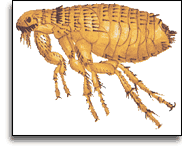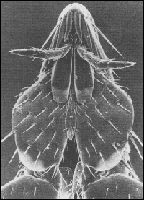 The
body of the flea is well adapted to its ectoparasitic life-style. Dark colored
adults are flattened from side to side with many bristles that point backwards,
facilitating forward movement through fur, hair, or feathers, and attachment
to the host. The presence of general combs also serves to help anchor the
flea to the host preventing its dislodgement. Fleas are wingless creatures,
with strongly developed legs, and hind legs that are especially adapted
for jumping. They have sucking mouthparts designed to feed on the blood
of mammals and birds. Their life cycle undergoes what is known as a "complete
metamorphosis"; that is, they have an egg, larval, pupal and adult stage.
The
body of the flea is well adapted to its ectoparasitic life-style. Dark colored
adults are flattened from side to side with many bristles that point backwards,
facilitating forward movement through fur, hair, or feathers, and attachment
to the host. The presence of general combs also serves to help anchor the
flea to the host preventing its dislodgement. Fleas are wingless creatures,
with strongly developed legs, and hind legs that are especially adapted
for jumping. They have sucking mouthparts designed to feed on the blood
of mammals and birds. Their life cycle undergoes what is known as a "complete
metamorphosis"; that is, they have an egg, larval, pupal and adult stage. The
males usually emerge first and are less numerous than the females. The female
flea will not mate and lay eggs unless she has obtained a blood meal. The
adults of many species of rodent or bird fleas visit their hosts for only
a short time in order to obtain their blood meal. Others attach to their
host for most of their lives.
The
males usually emerge first and are less numerous than the females. The female
flea will not mate and lay eggs unless she has obtained a blood meal. The
adults of many species of rodent or bird fleas visit their hosts for only
a short time in order to obtain their blood meal. Others attach to their
host for most of their lives.Egg production begins two days after the first available blood meal, with the greatest production on the sixth and seventh days. Estimates of the number of eggs laid per female cat flea range from 300 to 800. Fleas are often referred to humorously as "jumping dandruff" and they are indeed famed because of their saltatorial talents. The human flea is able to jump vertically 7,75 inches/20cm and horizontally 13 inches/33cm.
 It
must be emphasized that the role of the pest control operator does not include
the treatment of pets. However, when the professional operator proposes
to treat the building with insecticides, he may suggest the pet be treated
with product which do not cause this effect.
It
must be emphasized that the role of the pest control operator does not include
the treatment of pets. However, when the professional operator proposes
to treat the building with insecticides, he may suggest the pet be treated
with product which do not cause this effect.Under certain circumstances it may be necessary to have the pet treated. This can be accomplished by a veterinarian pet groomer or by the pet owner himself but should be done at the same time the premises are being treated.